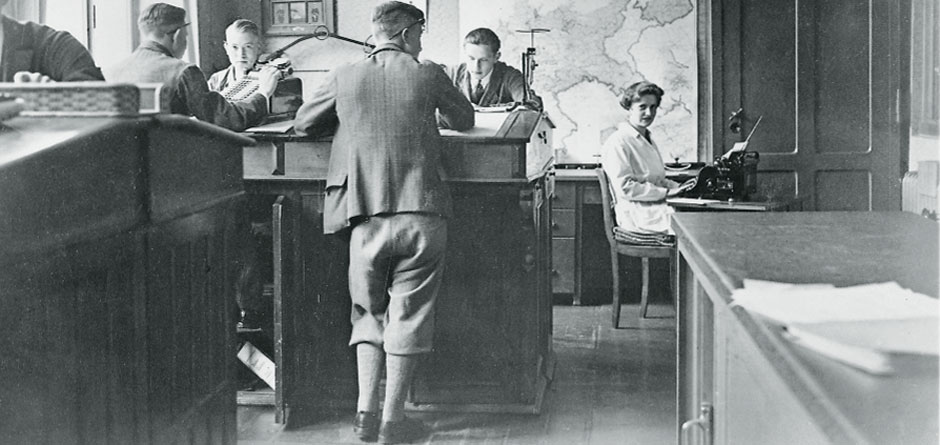A 1970 manual on workplace design refers to the modern office as an "information factory" - a phrase that was presumably coined as a result of the advance of electronic data processing into modern life. Computer centres, magnetic tape drives, visual display units, hitherto inconceivable memory capacity and data processing speeds heralded a new age in business and government offices. No matter how modern the machines and the organization seemed to be, it was not really new at all. The office has always been the place where people collect, process and file information, receiving it from others and passing it on to others. The cultural techniques of arithmetic and writing are just as necessary as PC skills for today's case workers.
The office - a microcosmos of daily life
An exhibition reviewing the history of information technology must include the office as a place where information is processed and machines are used.
The six settings on the history of offices from the Renaissance period to the years following World War II give an outline of this subject. They should not only be seen as picturesque scenes for the collected objects - ranging from quills to electric typewriters - but rather as a microcosmos of daily life, reflecting equally technical, social, economic and aesthetic trends. For example, documents written in standardized handwriting and uniforms in the "Prussian government office" reflect the rules of an administration that is viewed as a model because of its accuracy and frugality. When typewriters entered the "American office" in around 1900, it not only meant an efficient means of producing documents and copies but the emergence of new jobs. Trained typists, and later shorthand typists, worked in typing pools in the 1920s and replaced the writers and copyists of former days.
Structural change in the 19th and 20th centuries
Industrialization and urbanization, the two big structural changes in the 19th and 20th centuries, led to a huge increase in manufacturing workers in Europe and North America, whereas the number of people employed in agriculture fell constantly. As a corollary of this trend, however, there was a constant rise in the number of people who earned their living by working at desks in a sitting or standing position, or behind shop counters. They all belonged to a new class of clerk whose rise is inseparably linked with the increase in specialized office work in commerce, banking and industrial companies as well as in government, all of which were growing in size all the time.
Rationalisation of workflow
Day-to-day office work was and is characterized by paper. Mechanical or electric typewriters, forms with copies, conventional folders and files, and all kinds of copying equipment are the resources used by paper-based information processing. Innovations involving unspectacular techniques or technologies also helped to rationalize work. Examples of this include shorthand, card indexes and methods to rationalize work by optimizing repeated actions and boosting the performance of staff.
If the visionaries of the computer sector had their way, paper would already have disappeared from the office. In the 1980s, when numerous computers were already installed at workplaces and electronic mail first seemed realistic, inexpensive telefax machines flooded the market. And many bosses today still seem to find it easier to feed a sheet of paper into a machine and type in a telephone number rather than deal with their secretary's typing equipment - the personal computer. Low-cost workplace printers and photocopiers also helped to increase the consumption of cellulose. The utopia of a paperless office is still to come.
